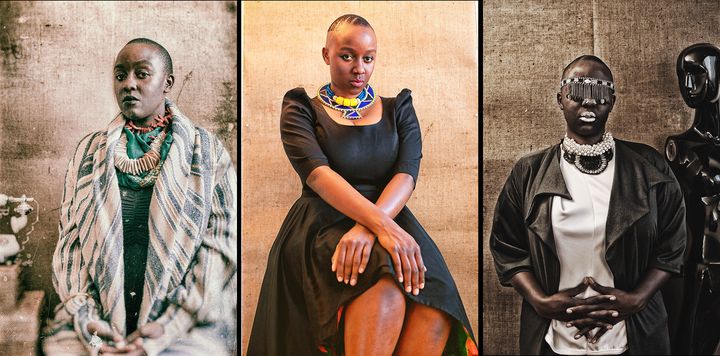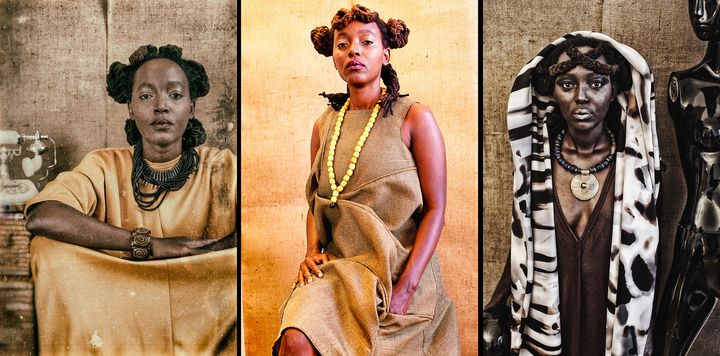African hair is magical. It transforms itself into different forms and still looks beautiful. Straight, dreadlocks, box braids, cornrows, perm rod curls, and every other curl you can think of -- our hair can do it.
But where does the styling of our hair come from?
The history of African hairstyles has not progressed, as such. Instead, it evolved into a new and fresh homage to styles of older ages. These styles are now popularised by the current wave of natural hair enthusiasts.

Hair styling also held deeper meaning. It was a means to differentiate societal classes from one another. For example, in 15 century Africa, hairstyles were used to indicate a person's marital status, age, religion, ethnic identity, wealth and rank within the community.
Esi Sagay's book, African Hairstyles, Styles Of Yesterday And Today, speaks to traditional hairstyles in each region of Africa and modern styles which make use of cornrows and threading. This book is a good starting point to understand how we are losing practices to take care of 4C hair, the curliest of African hair.
Many of us rely heavily on hair salons to teach us how to take care of our hair because we don't know how to treat, condition and groom it from the comfort of our own homes. This practice would not only save money but the hair itself. Sadly, based on anecdotal experience, we can safely say that there aren't that many hair salons trained in treating and caring for chemical-free hair.

Four women from Uganda, who form the collective The Salooni Project, have explored the evolution of African hair. Kampire Bahana, a writer-organiser; Darlyne Komukama, a photographer; Aida Mbowa, a theater buff; and Gloria Wavamunno, a fashion designer, make up the group.
They were talking about their own experiences as black women and the shared experiences at the hair salon -- the salooni, as it is referred to by a variety of black people across the continent. This inspired them to form their multidisciplinary art project. Through their work, they recreated a salon experience for those who attended their installation.
Photographer Komukana captured the work they do. Through the Salooni "Timeless" Photo Project, the artists took one style each and imagined it through time. This was their first big project together.

It was important for the team to make sure that the styles did not mimic or glorify white hair.
"For our first photo project, we shot a series of photos where we imagined a past, a present and a future where the characters in the photos keep the same hairstyle throughout the ages," Komukama said.
For the styling of the shoot, they took inspiration from different sources. Esi Sagay's book on hairstyles through time was one. Bahana said when she was growing up, the book was like a constant backdrop for their upbringing.
"When my sister and I would go and get our hair braided my mum would take it as a reference for the hairstylist and be like 'do something like this and change xyz'," she said.

For Bahana, the hairstyles both revealed and created an idea for her that these old hairstyles were cool and confirmed that they had always existed.
Another source of inspiration for The Salooni Project is the work of photographer J. D. 'Okhai Ojeikere. Born Johnson Donatus Aihumekeokhai Ojeikere in Nigeria, he is best known for his photo series, Hairstyles, where he took images of women in his home country who wore their hair in different, creative, expressive and culturally relevant ways. The over 1,000 images, taken from 1968 to 1999, have been celebrated and revered in different art exhibitions across the world.
At the 2017 edition of the Design Indaba held in South Africa, photographer Medina Dugger reimagined the work of Ojeikere in her piece: Chroma: An Ode to J. D. 'Okhai Ojeikere. Dugger is from California but she is based in Lagos, Nigeria. She also collaborated with a French multidisciplinary artist, Francois Beaurain, to adapt Chroma to Chromatin, an animated version of her stills. The work was intended to explore the relationship between design and colours in braiding, as well as the influence of geometry on the patterns of African culture.
Remember that time Solange Knowles performed "Cranes in the sky" with an amazing hairstyle that looked like a crown?
That was the work of interdisciplinary artist, Shani Crowe, from the U.S. on Chicago's south side. Her work, Braids, was shown by a non-profit organisation named 3Arts, which helps promote local artists. Crowe has been braiding hair since she was about 11 years old.
The artist braided her friends, took the pictures and edited them herself. The final product was a photo series with 10 black and white pictures that blew the mind of everyone who came across it on the internet last year.
She told Fusion, an online media platform, about her love for making women look like royalty.
"I really love the idea of making women that I know look regal, as regal as they are in real life," she said.
And that's all it boils down to, the crowing of our hair over different periods and the pride we feel wearing it.
